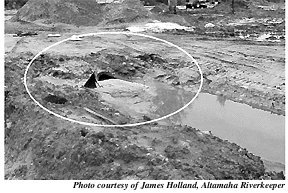Soil erosion a continuing threat to coastal waterways, fishing, and jobs
Despite state regulations meant to control soil erosion, stormwater runoff remains a major form of water contamination in Georgia.
Past regulation efforts have been erratically enforced and commonly violated. A 2002 performance audit of Georgia's Soil Erosion
and Sedimentation Program by the state auditor found numerous administrative, technical, and political obstacles that resulted in
failure to prevent water pollution caused by erosion.
Uniquely, this 27-year old Georgia environmental program allows counties to choose either to enforce regulations themselves or let
the Georgia Department of Natural Resource's Environmental Protection Division do it. While this local enforcement option may seem
to provide the advantage of hands-on county-level control by building inspectors, many citizens, property owners, and the non-profit
environmental groups that represent them often witness blatant disregard for measures that are legally required to protect water
contamination during construction.
These measures include the use of fine mesh screens called silt fences along ditches, creeks, wetlands, and other waterways, that
when properly installed and maintained keep soil particles from being washed off construction sites by rain. The state's law also
requires a 25-foot "buffer " along "waters of the state. " A buffer is a strip of land kept in natural vegetation that helps stabilize
soil and filter out various pollutants that would otherwise reach waterways. Both of these requirements are all too commonly ignored,
producing drastic impacts (see photos).
Among pollutants carried by eroded soil are petrochemicals from streets, driveways, and parking lots, as well as various organic compounds
that cumulatively add dangerous amounts of nitrogen and phosphorous to fish habitat, leading to a depletion of dissolved oxygen. In waters
with oxygen levels less than about 3 parts per million, no aquatic organisms can live. But even uncontaminated soil can itself cause harmful
turbidity' (suspended particles), compromising gill functions in fish and cutting off sunlight needed to support a healthy balance of plant
life, including essential micro-organisms.
In a recent study by Dr. Peter Verity, an environmental scientist at the Skidaway Institute of Oceanography near Savannah, direct correlations
were found between coastal development and reduced levels of dissolved oxygen. Findings from other studies, many in the Chesapeake Bay area,
strongly suggest that these correlations are produced by too much paving (radically increasing contaminated runoff), excessive use of
fertilizers and other chemicals that wash into waterways, and soil erosion - both in developing areas under construction and in other
land-disturbing activities such as farming, forestry, and mining.
Many casual observers may assume that contaminants coming out of pipelines are the dominant form of water pollution, but extensive studies
have found that non-point sources of pollution are a far greater threat to water quality, both here in Georgia and throughout the nation.
The most common type of non-point source pollution is stormwater that flows from higher areas into ditches, wetlands, and waterways, sweeping
all kinds of contaminants along with it - such as many already mentioned above. Eroded soils are among the most frequently cited types of
pollutants, in spite of Georgia's well-intended regulations.
In the Chesapeake drainage area, studies concluded that only about 22% of the 275 million pounds of oxygen-depleting nitrogen entering the bay
each year were coming from sewage. That means nearly four times as much of this major threat to productive fishing areas was caused by non-point
sources, including soil erosion. This non-point source pollution is destroying a once world-renowned fishing area, now extensively degraded.
We cannot allow Georgia's fishing areas to become the victim of similar negligence.
Although a comparable study has never been done in Georgia, it is reasonable to conclude that similar ratios exist here. If so, we could do much
to improve protection of prized and economically valuable fish habitat by simply enforcing regulations that are already on the books. Georgia's
coastal fisheries generate more than half a billion dollars annually in local business activity, and they are linked to wildlife habitat that
supports a comparable portion of our economy through activities such as bird-watching and eco-tourism.
Considering the quality of life and economic value of Georgia's water resources at risk, there is no excuse for tolerating the current rampant
violations of state law, such as the one depicted in the photo below. Protecting coastal Georgia's $1 billion nature-based business sector
depends on making a wise investment in enforcing soil erosion regulations. Local and state officials need to take this issue seriously before
further damage is done instead of "looking the other way " when developers fail to obey the law.

This photo shows a typical violation of the Soil Erosion & Sedimentation Act regulations, this one
in Glynn County. Silt fence, required to be used under state law meant to prevent stormwater on construction
sites from carrying soil into wetlands and waterways, has been covered with soil, which allows contamination to
occur. Despite such obvious violations, too often no corrective actions are taken by either state or local
authorities who are responsible for enforcing the regulations. Cumulatively, many unlawful practices causing erosion
in Georgia are producing serious water quality problems from non-point source pollution.
|